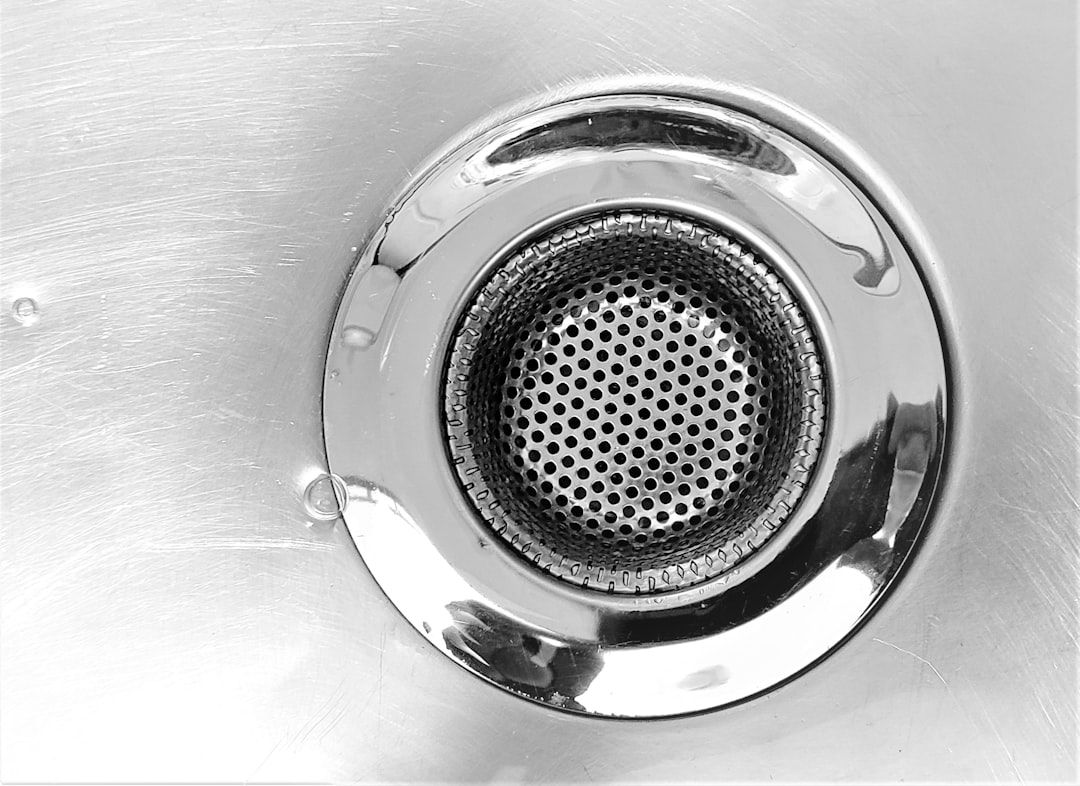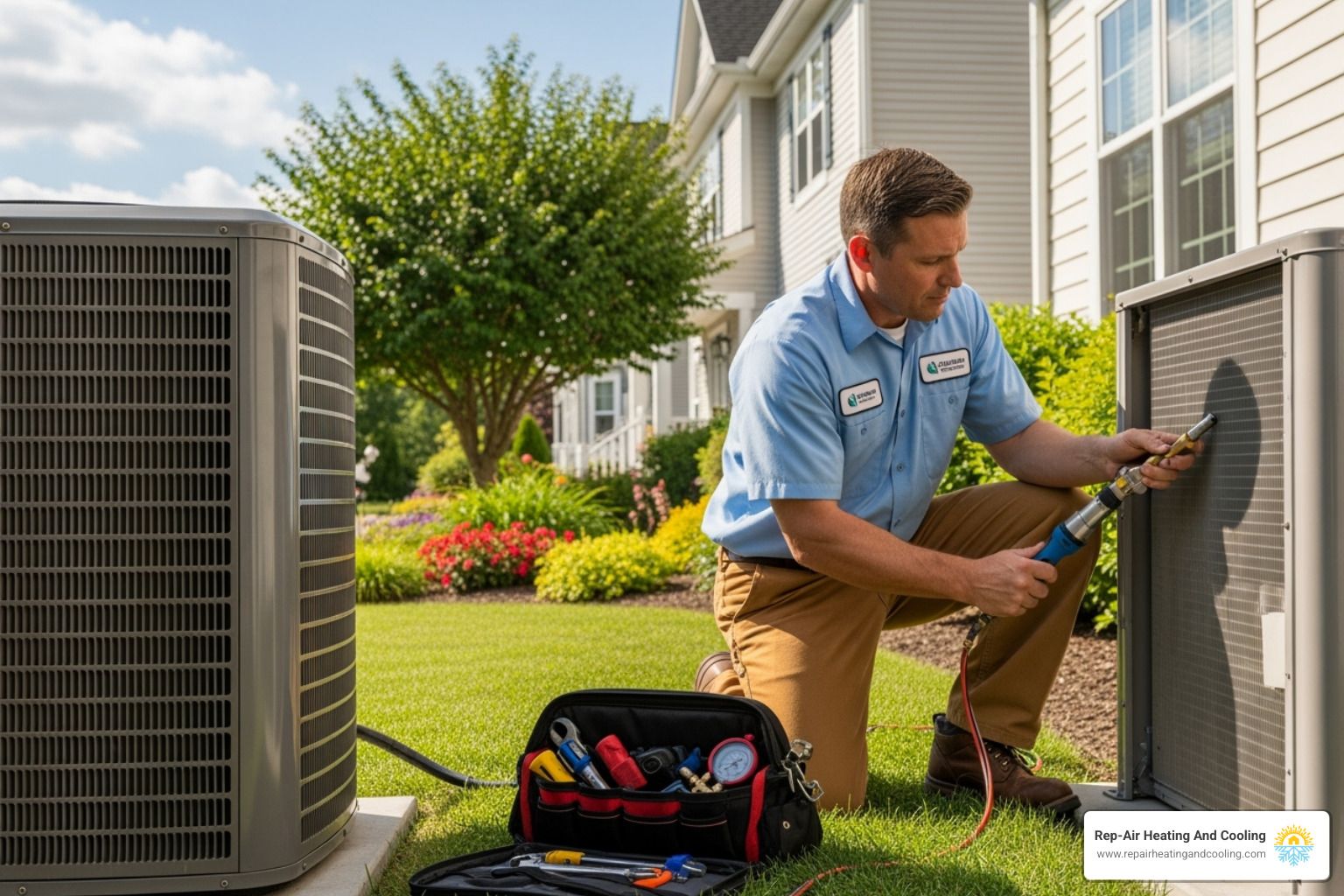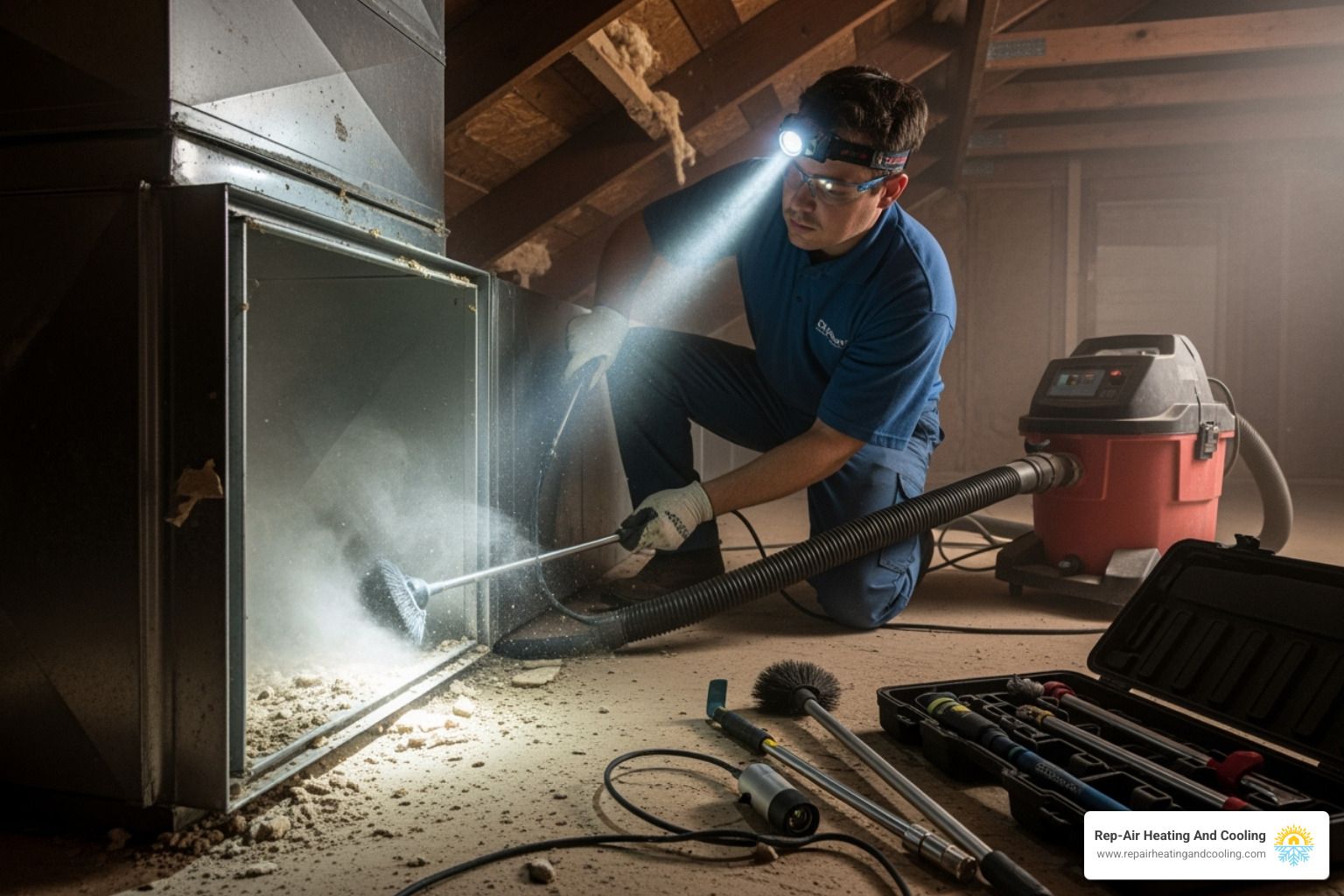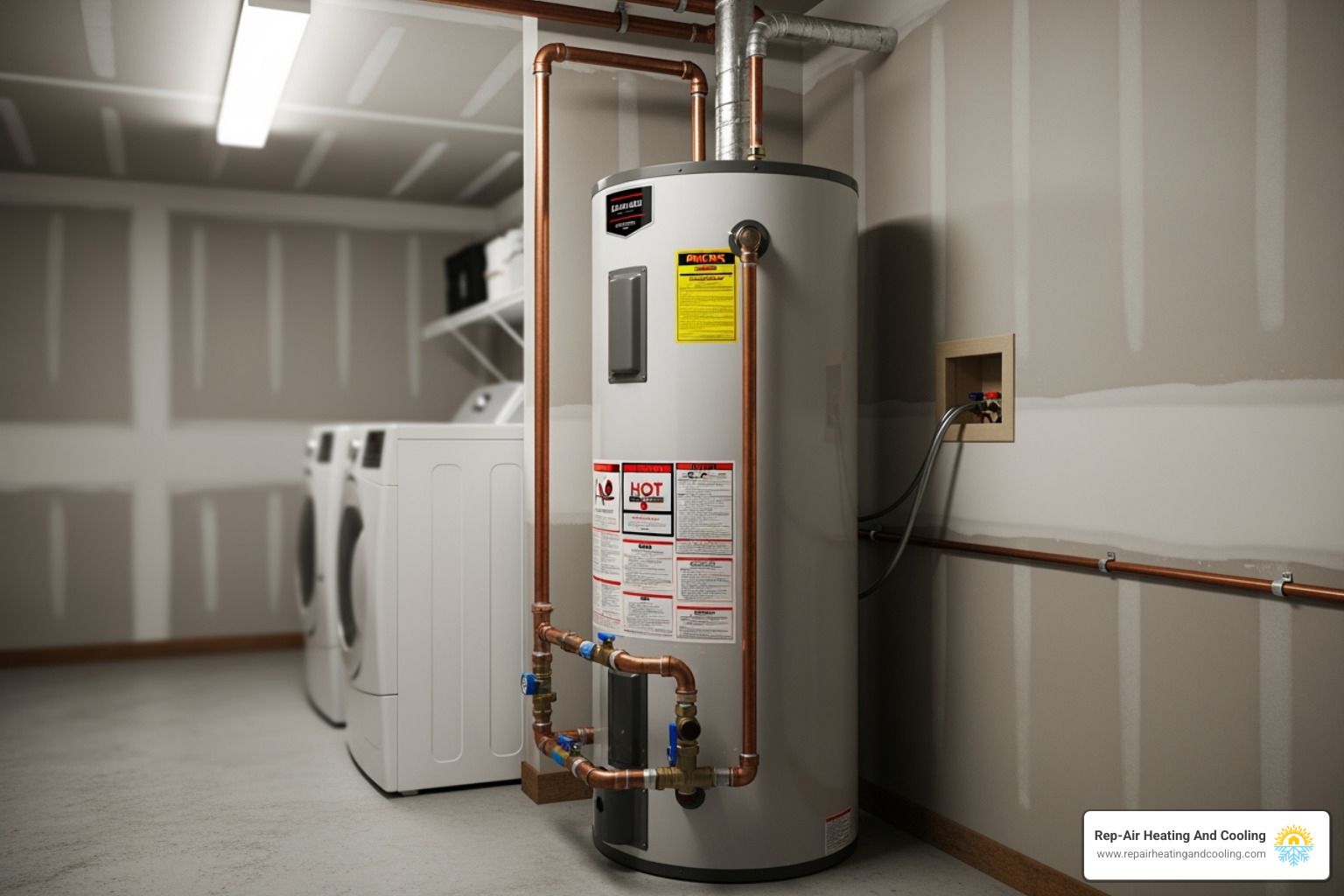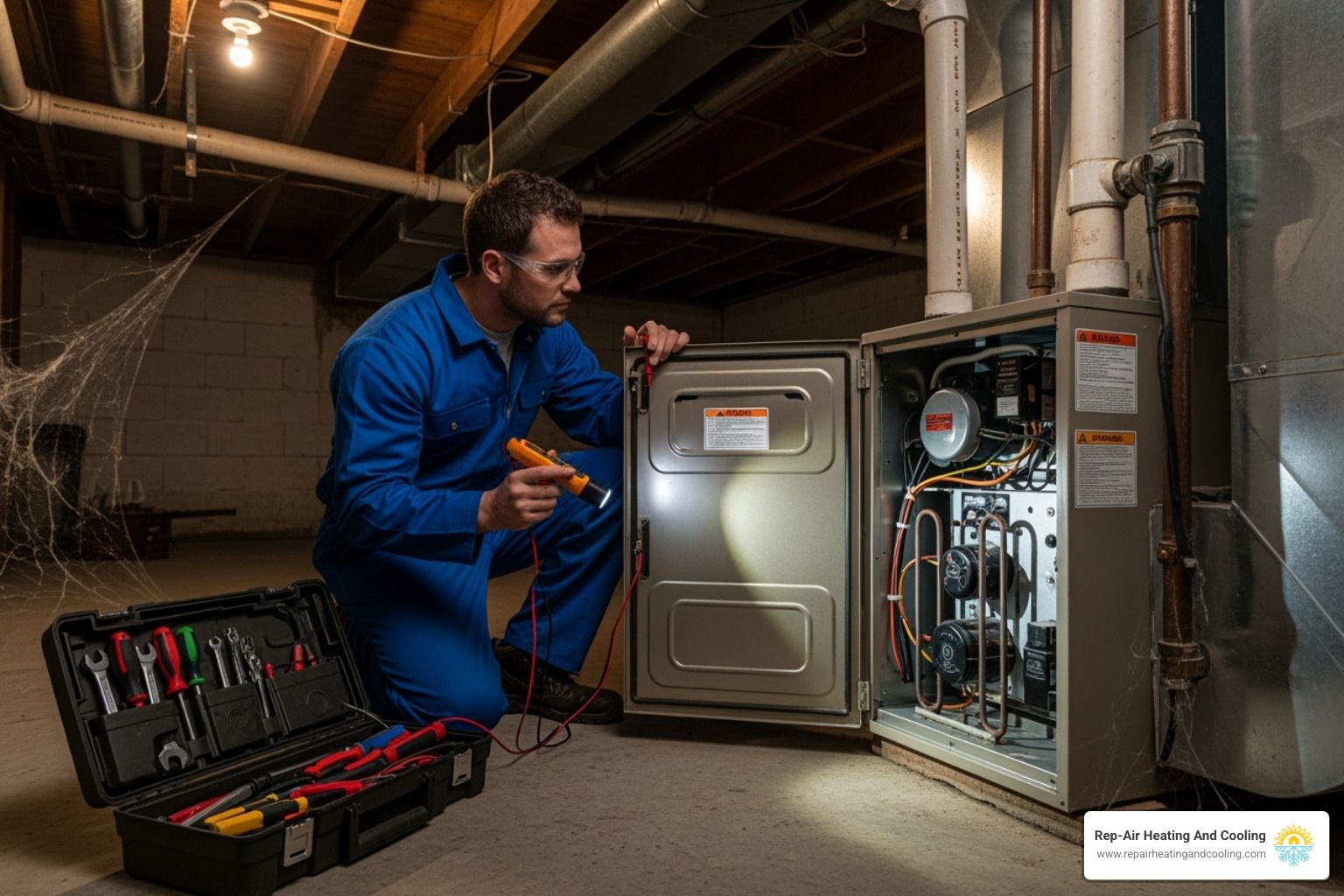Clearing the Air: Your Guide to Air Duct Cleaning
IMPORTANT NOTE: . Our company is located in British Columbia, Canada. If you are reading this article in another location, we hope you enjoy the information, but unfortunately we cannot service you.

Table of Contents
ToggleWhy Air Duct Cleaning Matters for Your Home
Air duct cleaning is the process of removing dust, debris, and contaminants from your home’s heating and cooling system. Professionals use specialized vacuum equipment to clean the supply and return air ducts, registers, grilles, and other components like the blower motor and coils.
Cleaning is generally recommended in specific situations, such as:
- Visible mold growth inside ducts
- Ducts infested with vermin (rodents or insects)
- Ducts clogged with excessive dust that gets released into your home
- After major home renovations
The process involves a professional assessment, the use of negative pressure and HEPA filtration to contain dust, and typically takes several hours to complete.
The topic of air duct cleaning is often debated. The EPA states there’s no conclusive evidence that routine cleaning prevents health problems, yet many homeowners report improved air quality and reduced allergy symptoms. The truth is that air duct cleaning isn’t a scam, but it’s not always necessary. It’s a conditional maintenance task that depends on your specific situation.
Since your HVAC system recirculates indoor air 5 to 7 times per day, the cleanliness of that system is worth considering. The key is understanding when cleaning is warranted versus when your money is better spent on regular filter changes or other indoor air quality improvements.
Handy air duct cleaning terms:
The Great Debate: Is Air Duct Cleaning Necessary?
Some homeowners swear by air duct cleaning, claiming dramatic improvements in their allergies and air quality. Others dismiss it as an expensive scam. The reality is somewhere in between, and understanding the facts can save you money and frustration.
The U.S. Environmental Protection Agency (EPA) takes a cautious stance, stating that routine duct cleaning hasn’t been proven to prevent health problems. They note that most dust in ducts sticks to the surfaces and doesn’t become airborne. Conversely, the National Air Duct Cleaners Association (NADCA) recommends cleaning every 3 to 5 years, as your home’s air recirculates through those ducts 5 to 7 times daily and contaminants can build up.
So who’s right? Both perspectives have merit. Air duct cleaning isn’t a universal necessity, but it’s not a scam either. It’s a conditional maintenance task—valuable under the right circumstances, unnecessary in others. The key is understanding that not all dusty ducts need cleaning, but contaminated ducts definitely do. For a comprehensive look at improving your indoor air quality, check out Ways to Improve Your Home’s Air Quality.
How to Tell if Ducts are Contaminated
How do you know if your ducts actually need cleaning versus just being normally dusty? Look for these clear signs:
- Visible dust blowing from your vents: If you see debris actively coming out of your supply registers when the system runs, it’s contaminating your living space.
- Persistent musty odors: Smells from your vents signal potential mold or mildew growth inside the ductwork.
- Uneven airflow: While not always a sign of contamination, significant dust buildup can restrict air movement. If you’re experiencing this, our guide on Poor Airflow Issues from AC Vents can help.
- Excessive dust on surfaces: If you notice an increase in dust on furniture despite regular cleaning, your ductwork could be the cause.
- Evidence of pests: Rodent droppings or insect nests in your ductwork are a clear and urgent indicator that cleaning is necessary.
These signs indicate that contaminants are actively affecting your indoor environment, making air duct cleaning a needed service rather than an optional one.
When to Schedule an Air Duct Cleaning Service
The EPA makes the decision clear by recommending air duct cleaning in three specific scenarios: when there’s visible mold growth, when ducts are infested with vermin, and when ducts are clogged with excessive dust and debris that’s being released into your home.
These are situations where your ductwork is actively degrading your indoor environment. Beyond these guidelines, air duct cleaning is also valuable for new homeowners unsure of the maintenance history, or if you’re dealing with unexplained allergies or asthma triggers that worsen when the HVAC system runs.
Post-construction situations are also important. Construction dust can easily find its way into your ductwork, circulating for months after a project is finished. For more on system care, see Ductwork Maintenance: Why It Matters.
5 Clear Signs You Need Duct Cleaning
Here are the most reliable indicators that your home would benefit from professional air duct cleaning:
- Visible debris blowing from registers
- Substantial visible mold growth
- Evidence of pests (droppings, nests)
- Ducts clogged with heavy dust
- Persistent musty or stale odors from vents
Special Cases: Renovations, Older Homes, and Allergies
Some situations make air duct cleaning particularly worthwhile:
- Post-renovation: Construction creates fine dust (drywall, sawdust) that can infiltrate and circulate through your ductwork. Cleaning removes these contaminants.
- Older homes: Homes built before the 1980s may have ductwork containing asbestos or lead dust. These require specialized handling and professional assessment before any cleaning.
- Allergen removal: If you’ve moved into a home where previous owners had pets, cleaning can help remove years of accumulated dander. It may also provide relief for those with severe allergies or asthma by removing trapped pollen or mold spores.
While not necessary for every home, air duct cleaning can make a significant difference when conditions are right. For more on IAQ solutions, explore our information on About Indoor Air Quality on Commercial & Residential HVAC services.
What a Professional Air Duct Cleaning Involves
A proper air duct cleaning is a sophisticated process requiring specialized equipment and trained technicians. It’s a precise and comprehensive service for your HVAC system.
Professional air duct cleaning is built on two key principles. First is negative pressure containment, where a powerful vacuum is connected to your ductwork to pull all dust and debris toward a single collection point. This prevents contaminants from entering your home.
Second is source removal with agitation. Technicians use tools like rotating brushes and compressed air whips to dislodge contaminants from duct surfaces while the system is under negative pressure. A reputable company will also provide before-and-after video inspection to verify the work and use HEPA filtration on any vacuum equipment that exhausts air indoors. For more details, visit our Duct Cleaning page.
The Full Scope of a Proper System Cleaning
A thorough job involves cleaning your entire HVAC system to prevent recontamination. This includes:
- Supply and return ducts: The pathways that carry air throughout your home.
- Blower motor and assembly: The heart of your system’s air movement. A dirty blower reduces efficiency and can recontaminate clean ducts.
- Evaporator coil: This component cools your air and can be a breeding ground for mold. A dirty coil can reduce efficiency by up to 30%.
- Condensate drain pan: Collects moisture and can harbor mold and bacteria if not cleaned.
- Registers and grilles: These are removed and hand-washed.
- Plenums: The large boxes connecting ductwork to your furnace, which often accumulate debris.
This comprehensive approach ensures your entire system works to maintain clean air. Learn more about How HVAC Services Improve IAQ.
The Risks of an Improper Air Duct Cleaning Job
Improper cleaning can make your indoor air quality worse. Key risks include:
- Ductwork damage: Aggressive techniques can tear flexible ductwork or dislodge fiberglass liners.
- Releasing contaminants indoors: Without proper negative pressure containment, cleaning can stir up dust, mold, and allergens.
- Dislodging hazardous materials: In older homes, improper cleaning can disturb asbestos or lead dust, creating severe health hazards.
- Incomplete cleaning: Skipping components like the blower or coils leads to rapid recontamination.
- Bait-and-switch scams: Be wary of low-price offers that lead to aggressive upselling. A legitimate company provides a transparent scope of work upfront.
To ensure proper service, choose companies that follow the ACR, The NADCA Standard for Assessment, Cleaning & Restoration of HVAC Systems. The difference between a proper air duct cleaning and a poor one is significant.
Beyond Cleaning: A Holistic Approach to Indoor Air Quality
While air duct cleaning is helpful in certain situations, it’s just one piece of the indoor air quality puzzle. A whole-home approach is most effective for keeping your air fresh and healthy.
Here are other important steps you can take:
- High-MERV Filters: Upgrading to a filter with a MERV rating of 8 to 11 is an effective way to capture common allergens like pollen, dust mites, and pet dander.
- Regular Filter Changes: A clogged filter restricts airflow and makes your system work harder. Check your filter monthly and change it every 1-3 months.
- Duct Sealing and Insulation: Leaky ducts can lose 20-30% of your conditioned air and pull in contaminants. Sealing these leaks improves comfort and energy efficiency.
- Humidity Control: Maintaining home humidity between 30% and 50% is ideal. Too much humidity encourages mold and dust mites, while too little can cause respiratory irritation.
- Whole-Home Air Purifiers: These systems work with your HVAC to continuously remove pollutants using advanced filters, UV lights, or other technologies.
Proactive steps like these can reduce the need for frequent air duct cleaning. Learn more about Enhancing Indoor Air Quality with Filtration.
The Role of Chemicals: Sanitizers and Biocides
The use of chemicals like sanitizers or biocides in ducts should be approached with caution. The EPA notes there is little evidence that routine chemical treatment is beneficial. Biocides should only be used by a trained professional to address confirmed mold growth after the underlying moisture problem is fixed. Sanitizers or deodorizers may mask odors but don’t solve the root cause of contamination. It’s usually best to stick to a thorough mechanical cleaning. For more on keeping things clean, see these Tips to Keep Your Air Filter Clean.
Don’t Forget Your Dryer Vent
Your dryer vent, while separate from your HVAC system, also needs regular cleaning. A clogged dryer vent is a serious fire safety hazard because lint is highly flammable. It also reduces dryer efficiency, forcing the appliance to run longer and use more energy.
Signs of a clogged vent include clothes taking too long to dry, the dryer feeling very hot, or a burning smell. We recommend professional dryer vent cleaning at least once a year. This simple task is a great addition to your home maintenance checklist, which can be managed with our Maintenance Plans.
Frequently Asked Questions about Air Duct Cleaning
We understand air duct cleaning can be a confusing topic. Here are straightforward answers to the questions we hear most often from homeowners.
How often should I get my air ducts cleaned?
There’s no magic number. While NADCA suggests every 3 to 5 years, a condition-based approach is better. Consider cleaning if you have pets that shed, household members with allergies or asthma, or smokers in the home. A recent renovation is another good reason. The best way to know for sure is a visual inspection by a qualified professional if you notice warning signs like visible dust from vents or musty odors.
Can air duct cleaning reduce my allergies or asthma symptoms?
It’s possible, but not guaranteed. The EPA states there’s no conclusive scientific evidence that routine cleaning prevents health problems. However, if your ducts contain specific allergens like heavy pet dander from a previous owner, mold spores, or pollen, removing these sources could provide relief. Air duct cleaning is not a cure for allergies or asthma, and realistic expectations are important. For more comprehensive solutions, explore our Indoor Air Quality Services.
Will duct cleaning improve my HVAC system’s efficiency?
Cleaning the ducts alone rarely leads to dramatic efficiency gains. The biggest improvements come from cleaning other system components. A clean blower motor and assembly improves airflow, while a clean evaporator coil can significantly boost efficiency—a dirty one can reduce it by up to 30%. For major efficiency gains, focus on regular filter changes and duct sealing, which can prevent 20-30% air loss. If you have uneven temperatures, the issue is more likely related to duct design or insulation, not just dirt. Read more about Common Causes of Uneven Cooling to understand what might be happening.
Bottom line: A full system cleaning contributes to efficiency, but it’s not the miracle fix some companies claim.
Conclusion
When it comes to air duct cleaning, the truth is that it’s a specialized maintenance service that can make a real difference when the conditions are right—it’s neither a cure-all nor a waste of money. Think of it as a necessary task when there’s a genuine need, like visible mold, pests, or heavy debris.
Effective air duct cleaning is a complete system cleaning. It must address the blower motor, evaporator coil, and other components to prevent rapid recontamination. Without this comprehensive approach, the service is incomplete.
Your best defense against needing frequent cleanings is proactive maintenance. Regular changes with high-MERV filters, proper duct sealing, and humidity control will keep your system cleaner for longer.
Be smart about who you hire. Avoid “too good to be true” offers, which often lead to subpar work. A professional job takes time, specialized equipment, and expertise.
For a comprehensive assessment of your home’s ductwork and overall indoor air quality in the Lower Mainland, trust the certified professionals at Rep-Air Heating And Cooling. We’re here to help you clear the air and ensure your home is a healthy, comfortable space.
Learn more about our services in Mission and the surrounding areas
Request your service today!
Our team of highly trained technicians are standing by ready to help you out with all of your service, repair, and installation needs. You can count on us for on-time repairs, professional installation, and the friendliest customer service in town!Contact Rep-Air Heating & Cooling today to get started with service by requesting a quote online, or by phone at (844) 218-3362.
Request Service
Contact us today to request an estimate or schedule service.






